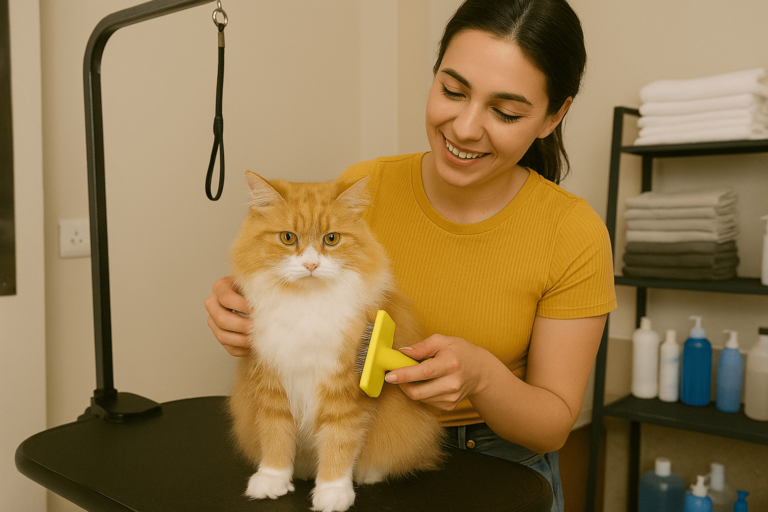
Even if you cannot be with your furry buddy, as a pet parent you want the greatest care for them. If you’re traveling or otherwise absent, boarding your cat can be a great fix; but, if you want a seamless transfer, you must first equip your feline friend for the experience. Little planning goes a long way toward keeping cats comfortable and stress-free, as they are creatures of habit and might be sensitive to changes in their surroundings. This detailed advice will enable you to get your cat ready for travel.
1. Select the Appropriate Boarding Facility
Choosing a facility fit for your cat comes first. Investigate and visit nearby boarding houses to choose one that is hygienic, respectable, and manned by kind experts. Look for a facility with separate spaces for dogs and cats since this helps to lower stress. Investigate for:
Cleanliness of conditions
Adequate temperature control and airflow
Cozy and secure enclosures
Employees certified in feline care
Daily activities comprising feeding, cleaning, and playfulness
Reading reviews and getting advice from your veterinarian or other cat owners is also a smart option. Selecting the best cat boarding house will provide you comfort and guarantee that your cat is under capable care.
2. Plan a Vet Check-Up
Plan a visit to your veterinarian before you board your cat. Proof of current vaccinations—including those for rabies and feline distemper—is required by many boarding houses. Others could also advise immunizations against Bordetella or feline leukemia. A check-up ensures your cat’s health and suitability for boarding. Take advantage of this chance to:
Correct immunizations.
Refill any prescriptions your pet might require.
Address any health issues.
Since most institutions will request your cat’s medical records throughout the admission process, have a copy ready.
3. Show Your Cat the Carrier
Since cats usually associate their carriers with unpleasant visits to the veterinarian, it’s crucial to make the carrier a more joyful experience. Spend the weeks before boarding leaving the carrier open in a familiar area. To make it appealing, toss in a cozy blanket or one of your cat’s favorite toys. Treats or catnip will also encourage your cat to investigate and enter the carrier on their own.
Making a positive association with the carrier can help reduce the stress of getting your cat to the boarding station.
4. Pack Familiar Objects
Bringing a few things from home will help your cat relax and lower their anxiety while they’re away. Consider packing:
A favorite blanket or sleeping cover
Toys they like to play with
An article of clothing bearing your scent
In the boarding setting, these objects foster security and familiarity. To prevent confusion, label everything with your cat’s name.
5. Maintain Your Cat’s Routine
Cats thrive on habit, so strive to keep their feeding and play times consistent before boarding. Provide the boarding house with comprehensive instructions on your cat’s diet, feeding schedule, and any particular preferences or restrictions. Make sure the staff understands the precise dosage and administration schedule if your cat takes medication.
Maintaining regularity in their activities will help your cat adjust to the new environment more naturally.
6. Get Your Cat Used to New Sounds and Smells
Particularly in cases where other animals are nearby, boarding facilities can be noisy. At home, progressively introduce your cat to various sounds and odors to help them adapt. You might introduce fresh smells using diffusers or sprays or play low-level recordings of animal sounds. These small exposures help to reduce the overwhelming nature of boarding.
7. Organize a Trial Run
If your cat has never been boarded before, think about a short stay. This might last one day or one weekend. A trial run lets you see how well your cat adjusts and encourages them to grow familiar with their surroundings. It also gives the boarding staff a chance to learn the needs and characteristics of your cat.
Observe how your cat behaves when you get home following the trial stay. This will help you understand any adjustments you might need to make for a longer stay.
8. Apply Calming Products
Calming items, including collars, diffusers, or pheromone sprays, assist in lowering your cat’s stress. These products have a relaxing effect by simulating natural feline pheromones. Start using them at home a few days before boarding and continue during their stay. Additionally, ask your veterinarian whether any mild sedatives or anti-anxiety medications might be suitable for your cat.
9. Stay Calm During Drop-Off
You too may have an emotional experience leaving your cat behind. However, cats are instinctual and can sense your uneasiness. Throughout the drop-off process, remain calm to avoid transferring any anxious energy to your cat. Trust that the boarding house will look after your furry friend and focus on the positive aspects of their stay, such as socialization and new experiences.
10. Observe Your Cat Post-Boarding
Pay attention to your cat’s behavior and overall appearance when you pick them up. Cats often act a bit differently for a day or two after boarding as they adjust to being home. However, if you observe any symptoms of illness or prolonged stress, consult your veterinarian or the boarding facility.
Ask the boarding staff about your cat’s stay. Understanding how your cat managed will enable you to make any necessary adjustments for future boarding trips.
Closing Notes
Getting your cat ready for boarding calls for meticulous preparation and consideration of their specific needs. You can make the experience as pleasant as possible by selecting the right facility, maintaining routines, and packing familiar items. Knowing your cat is being cared for can help you relax, whether your trip is brief or long.
Remember that a positive boarding experience depends largely on communication and preparation. With these tips, your cat will be ready to thrive in a new environment while you’re away.





